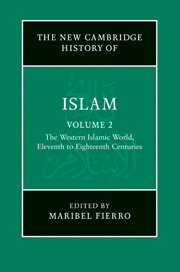Book contents
- Frontmatter
- Introduction
- PART I AL-ANDALUS AND NORTH AND WEST AFRICA (ELEVENTH TO FIFTEENTH CENTURIES)
- 1 Al-Andalus and the Maghrib (from the fifth/eleventh century to the fall of the Almoravids)
- 2 The central lands of North Africa and Sicily, until the beginning of the Almohad period
- 3 The Almohads (524–668/1130–1269) and the Ḥafṣids (627–932/1229–1526)
- 4 The post-Almohad dynasties in al-Andalus and the Maghrib (seventh–ninth/thirteenth–fifteenth centuries)
- 5 West Africa and its early empires
- PART II EGYPT AND SYRIA (ELEVENTH CENTURY UNTIL THE OTTOMAN CONQUEST)
- PART III MUSLIM ANATOLIA AND THE OTTOMAN EMPIRE
- PART IV NORTH AND WEST AFRICA (SIXTEENTH TO EIGHTEENTH CENTURIES)
- PART V RULERS, SOLDIERS, PEASANTS, SCHOLARS AND TRADERS
- Glossary
- Bibliography
- Index
- References
3 - The Almohads (524–668/1130–1269) and the Ḥafṣids (627–932/1229–1526)
from PART I - AL-ANDALUS AND NORTH AND WEST AFRICA (ELEVENTH TO FIFTEENTH CENTURIES)
Published online by Cambridge University Press: 28 March 2011
- Frontmatter
- Introduction
- PART I AL-ANDALUS AND NORTH AND WEST AFRICA (ELEVENTH TO FIFTEENTH CENTURIES)
- 1 Al-Andalus and the Maghrib (from the fifth/eleventh century to the fall of the Almoravids)
- 2 The central lands of North Africa and Sicily, until the beginning of the Almohad period
- 3 The Almohads (524–668/1130–1269) and the Ḥafṣids (627–932/1229–1526)
- 4 The post-Almohad dynasties in al-Andalus and the Maghrib (seventh–ninth/thirteenth–fifteenth centuries)
- 5 West Africa and its early empires
- PART II EGYPT AND SYRIA (ELEVENTH CENTURY UNTIL THE OTTOMAN CONQUEST)
- PART III MUSLIM ANATOLIA AND THE OTTOMAN EMPIRE
- PART IV NORTH AND WEST AFRICA (SIXTEENTH TO EIGHTEENTH CENTURIES)
- PART V RULERS, SOLDIERS, PEASANTS, SCHOLARS AND TRADERS
- Glossary
- Bibliography
- Index
- References
Summary
The Almohad caliphate
The mahdī Ibn Tūmart and the Almohad movement
Ibn Yāsīn, the founder of the Almoravid movement, is depicted as a Mālikī jurist engaged in transforming the Lamtūna Berbers into good Mālikī Muslims, a mission he accomplished by resorting often to physical punishments. His teachings were transmitted for some time, but eventually forgotten. Despite both his relevance and the prominence of the Mālikī school under the Almoravids, Ibn Yāsīn did not come to play a central role either in western Mālikism or in Almoravid political legitimisation.
Ibn Tūmart, the founder of the Almohad movement, also aimed at a moral and religious reform. Accounts of Ibn Tūmart’s life more detailed than those of Ibn Yāsīn, as well as the ‘Book’ (Kitāb) attributed to him, are extant. The Almohad numismatic formula Allāhu rabbunā wa-Muḥammad rasūlunā wa’l-mahdī imāmunā (God is our Lord, Muḥammad is our Prophet, the mahdī [i.e. Ibn Tūmart] is our imām) bears witness to the central role he was accorded in the new polity. However, our understanding of how and when those accounts of his life were written down is still faulty, apart from the obvious fact that they moulded Ibn Tūmart’s life according to the Prophet’s biography. Much of the portrayal of Ibn Tūmart comes from the ‘Memoirs’ of al-Baydhaq, whose aim is nevertheless chiefly to establish ʿAbd al-Muʾmin’s right to lead the Almohads as caliph.
- Type
- Chapter
- Information
- The New Cambridge History of Islam , pp. 66 - 105Publisher: Cambridge University PressPrint publication year: 2010
References
- 2
- Cited by



